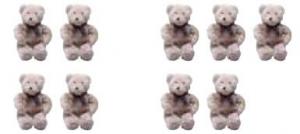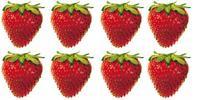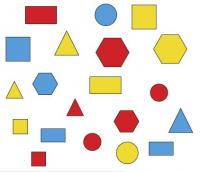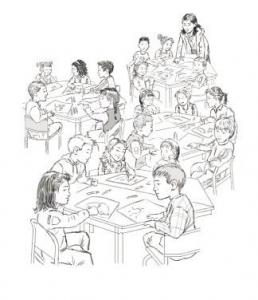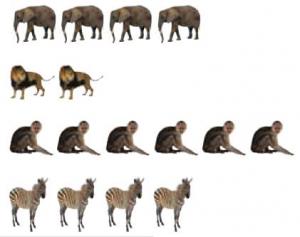After one year at school
Number and algebra | Geometry and measurement | Statistics
The following problems and descriptions of student thinking exemplify what is required to meet this standard.
Number and algebra
In contexts that require them to solve problems or model situations, students will be able to:
- apply counting-all strategies
- continue sequential patterns and number patterns based on ones.
During this school year, 'number' should be the focus of 60–80 percent of mathematics teaching time.
Example 1
Imagine you have 4 teddies. You get 5 more teddies.
How many teddies do you have now?
The student gets the correct answer of 9 teddies by counting all of the objects: 1, 2, 3, 4, 5, 6, 7, 8, 9. They may do so by imaging the teddies, preferably, or by using substituted materials (for example fingers or counters). If they successfully use a more sophisticated strategy, such as counting on or doubling, they exceed the expectation.
Example 2
Imagine you have 8 strawberries.
You eat 3. How many strawberries do you have left?
The student gets the correct answer of 5 strawberries by counting all the objects (1, 2, 3, 4, 5, 6, 7, 8) and then counting back (7, 6, 5). They may do so by imaging the strawberries, preferably, or by using substituted materials (for example fingers or counters). If they successfully use a more sophisticated strategy, such as immediately counting back from 8 or using known facts, they exceed the expectation.
Example 3
Here are 3 kete. There are 3 kūmara in each kete.
How many kūmara are there altogether?
The student gets the correct answer of 9 kūmara by counting all of the objects: 1, 2, 3, 4, 5, 6, 7, 8, 9. They may do so by imaging the kūmara, preferably, or by using substituted materials (for example fingers or counters). If they successfully use a more sophisticated strategy, such as skip-counting (3, 6, 9), they exceed the expectation.
Example 4
Build up the pattern below with your animal cards, one animal at a time, in front of the student.
Which animal comes next in the pattern? How do you know?
The student identifies which animal comes next (the pig) by attending to its relative position in the repeating sequence: cow, pig, sheep.
Return to top
Geometry and measurement
In contexts that require them to solve problems or model situations, students will be able to:
- compare the lengths, areas, volumes or capacities, and weights of objects directly
- sort objects and shapes by a single feature and describe the feature, using everyday language
- represent reflections and translations by creating patterns
- describe personal locations and give directions, using everyday language.
Example 5
Provide water in an ungraduated jug or bottle and 3 containers that are similar in capacity.
Use water to find out which container holds the most.
The student pours water directly from one container to another to find out which holds the most.
Example 6
Provide the student with a set of attribute blocks.
Sort the blocks into families.
What is the same about the blocks in each family?
The student sorts the blocks by a feature of their choice and explains their sorting. The feature may be colour, size, shape, thickness, or some other characteristic, such as number of sides, symmetry, 'pointiness', or 'roundness'.
Example 7
Sit with the student at their desk in the classroom.
Imagine I am standing at the door. I need to get to where Rawiri sits. Tell me how to get to his seat.
The student gives clear directions that lead you to Rawiri’s seat. They may tell you to move backwards or forwards and to turn right or left. If the student specifies distances in steps or metres or uses half- or quarter-turns, they exceed the expectation.
Return to top
Statistics
In contexts that require them to solve problems or model situations, students will be able to:
- investigate questions by using the statistical enquiry cycle (with support), gathering, displaying, and/or counting category data.
Example 8
Provide the student with the animal cards shown, randomly arranged.
Arrange the cards so that someone else can see how many of each animal there are at the zoo. How many zebras are there? Which animal is there most of?
The student sorts the animals into categories and displays the number of animals in each category, using a set grouping or pictograph as above. They correctly answer that there are 4 zebras and more monkeys than any other animal.
Published on: 13 Oct 2009
Return to top


